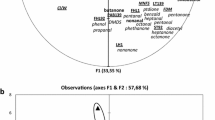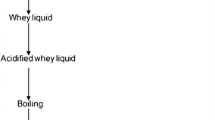Abstract
The autochthonous lactic microflora involved in the production of the artisanal “Pecorino di Tramonti” cheese—a ewe’s milk cheese—was evaluated at the date of production and during ripening. Two batches, spicy and mild (not spicy) cheese, of premium quality Pecorino di Tramonti were produced from raw ewe’s milk without starter cultures, according to a very traditional technique. Lactic acid bacteria were monitored by counting on selective media. Counts for mesophilic rods and cocci on MRS and LM17 ranged from 6 to 8 Log CFU/g, respectively, during the entire ripening, but different growth trends could be observed between the two kinds of cheese. Enterococcal levels increased during the 1st month and decreased thereafter throughout ripening. A total of 169 cultures was selected randomly and identified by numerical analysis of ribopatterns. Ribotypes could be grouped in five clusters corresponding to different taxons. Enterococcus faecium proved to be the dominant species, followed by Lactococcus lactis subsp. lactis, L. lactis subsp. cremoris, Enterococcus faecalis and Enterococcus durans.




Similar content being viewed by others
References
Aquilanti L, Dell’Aquila L, Zannini E, Zocchetti A, Clementi F (2006) Resident lactic acid bacteria in raw milk canestrato pugliese cheese. Lett Appl Microbiol 43:161–167
Björkroth J, Korkeala HJ (1996) Evaluation of Lactobacillus sake contamination in vacuum packaged sliced cooked meat products by ribotyping. J Food Prot 59:398–401
Bonomo MG, Salzano G (2012) Microbial diversity and dynamics of pecorino di Filiano PDO, a traditional cheese of Basilicata region (southern Italy). Int J Dairy Technol 65(4):531–541
Caridi A, Micari P, Caparra P, Cufari A, Sarullo V (2003) Ripening and seasonal changes in microbial groups and in physico-chemical properties of the ewes’ cheese Pecorino del Poro. Int Dairy J 13:191–200
Cogan TM, Barbosa M, Beuvier E, Bianchi-Salvadori B, Cocconcelli PS, Fernandes I, Gomez J, Gomez R, Kalantzopoulus G, Ledda A, Medina M, Rea MC, Rodriguez E (1997) Characterization of the lactic bacteria in artisanal dairy products. J Dairy Res 64:409–421
Giraffa G (2002) Enterococci from foods. Microbiol Rev 744:1–9
Koort J, Coenye T, Vandamme P, Sukura A, Bjorkroth J (2004) Enterococcus hermanniensis sp. nov., from modified-atmosphere-packaged broiler meat and canine tonsils. Int J Syst Evol Microbiol 54:1823–1827
Koort J, Murros A, Coneye T, Eerola S, Vandamme P, Sukura A, Björkroth J (2005) Lactobacillus oligofermentans sp. nov., associated with spoilage of modified-atmosphere-packaged poultry products. Appl Environ Microbiol 71:4400–4406
Koort J, Coenye T, Vandamme P, Bjorkroth J (2006) Streptococcus parauberis associated with modified atmosphere packaged broiler meat products and air samples from a poultry meat processing plant. Int J Food Microbiol 106(3):318–323
Moreno MRF, Sarantinopoulos P, Tsakalidou E, De Vuyst L (2006) The role and application of enterococci in food and health. Int J Food Microbiol 106:1–24
Rahkila R, Johansson P, Säde E, Björkroth J (2011) Identification of enterococci from broiler products and a broiler processing plant and description of Enterococcus viikkiensis sp. Appl Environ Microbiol 77(4):1196–1203, 23
Randazzo CL, Pitino I, Ribbera A, Caggia C (2010) Pecorino crotonese cheese: study of bacterial population and flavour compounds. Food Microbiol 27:363–374
Regnault B, Grimont F, Grimont PAD (1997) Universal ribotyping method using a chemically labelled oligonucleotide probe mixture. Res Microbiol 148:649–659
Ricciardi A, Blaiotta G, Di Cerbo A, Succi M, Aponte M (2014) Behaviour of lactic acid bacteria populations in pecorino di carmasciano cheese samples submitted to environmental conditions prevailing in the gastrointestinal tract: evaluation by means of a polyphasic approach. Int J Food Microbiol 179:64–71
Serio A, Paparella A, Chaves-Lopez C, Corsetti A, Suzzi G (2007) Enterococcus populations in pecorino abruzzese cheese: biodiversity and safety aspects. J Food Prot 70(7):1561–1568
Tarakci Z, Temiz H (2009) A review of the chemical, biochemical and antimicrobial aspects of Turkish otlu (herby) cheese. Int J Dairy Technol 62(3):354–360
Acknowledgements
This work was supported financially by the Veterinary Doctors Order of Salerno Province. The authors thank the cheese producers for providing samples.
Conflict of interest
The authors declare that they have no competing interests.
Author information
Authors and Affiliations
Corresponding author
Rights and permissions
About this article
Cite this article
Mormile, A., Barile, M., Mercogliano, R. et al. Dynamics of lactic acid bacteria in “Pecorino di Tramonti”—a ewe’s milk cheese—with particular emphasis on enterococci: a preliminary study. Ann Microbiol 66, 179–185 (2016). https://doi.org/10.1007/s13213-015-1094-1
Received:
Accepted:
Published:
Issue Date:
DOI: https://doi.org/10.1007/s13213-015-1094-1




